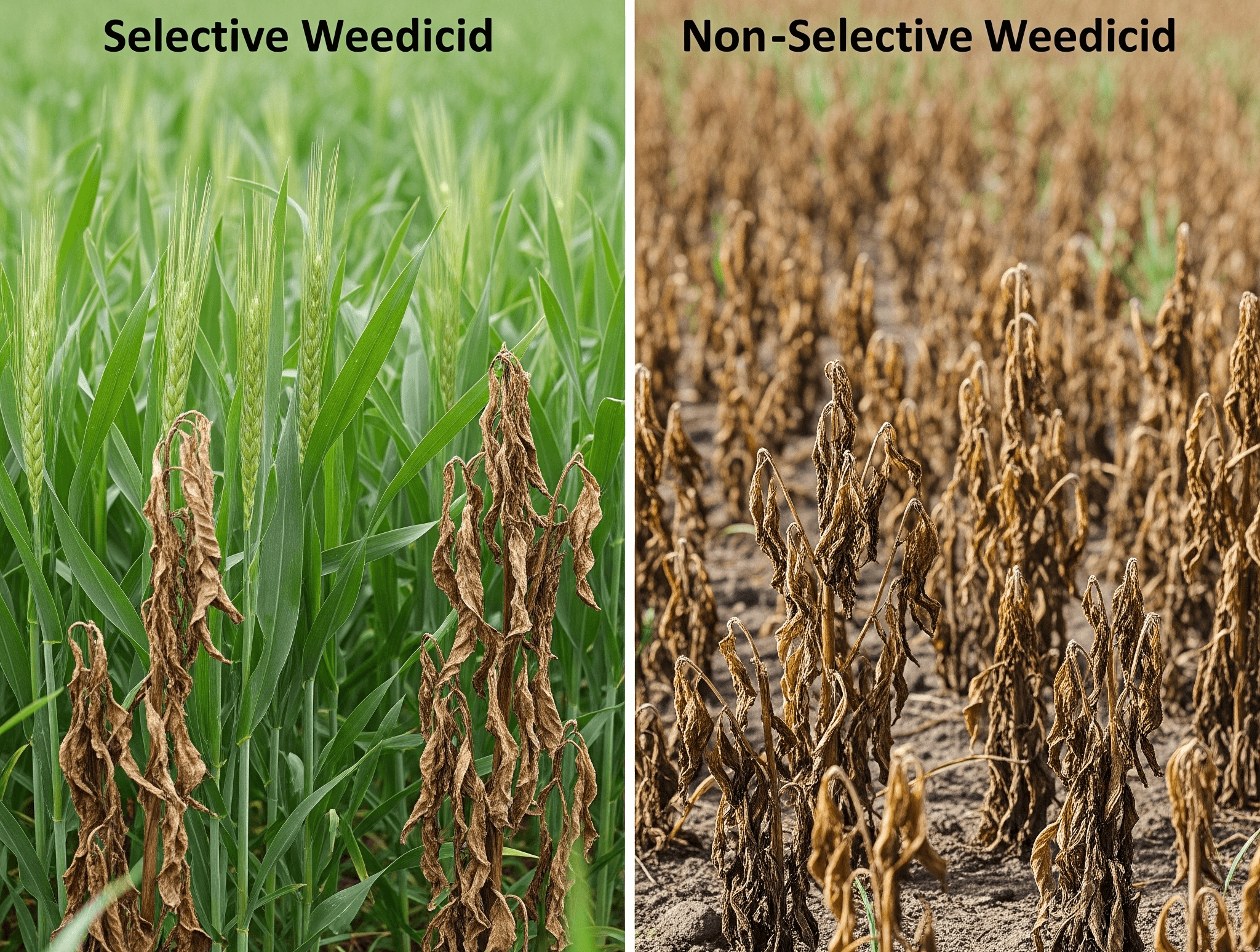
Mode of Action of Herbicides
Definition: The mode of action of a herbicide refers to the sequence of biological events in plants from the time the herbicide is absorbed until the plant dies.
It includes:
- How the herbicide enters (contact or absorption)
- How it moves (translocation)
- How it disrupts plant metabolism (toxicity mechanism)
- Final lethal effect (plant death)
A) Classification Based on Mode of Action
- Selective Herbicides: Kill specific weeds but spare the crop. Useful in mixed vegetation situations. Example: Atrazine (used in maize & sugarcane; kills broadleaf & grasses but not crop).
- Non-Selective Herbicides: Kill all vegetation they contact. Used for total vegetation control (pathways, non-crop lands, pre-planting burndown).Example: Paraquat (kills almost all green tissue on contact).
B) Stages of Herbicide Mode of Action
- Contact Action: Herbicide kills only the tissues it touches. No movement inside the plant. Works best on young weeds. Example: Paraquat → destroys chloroplasts → rapid wilting & necrosis.
- Absorption Herbicide enters via leaves, stems, or roots. Essential for systemic herbicides. Example: Glyphosate → absorbed through leaves → enters vascular tissues.
- Translocation (Movement inside plant); Systemic herbicides move to sites of action: Xylem (upward with water flow). Phloem (bidirectional with sugars). Example: 2,4-D → moves through phloem to meristems → kills broadleaf weeds.
- Toxicity (Biochemical Disruption) Herbicide interferes with vital processes:
-
- Photosynthesis (e.g., Atrazine → blocks electron transport in PS II).
- Amino acid synthesis (e.g., Glyphosate → blocks EPSPS enzyme).
- Lipid synthesis, protein synthesis, cell division, etc.
- Leads to stress and metabolic collapse.
-
- Death (Final Effect) Result of accumulated damage from biochemical disruption. Example: Glufosinate → inhibits glutamine synthetase → toxic ammonia builds up → cell death.
C) Herbicide Families Based on Mode of Action
i) Growth Regulator Herbicides
- Mode of Action: Mimic plant hormone auxin → disrupts normal growth → abnormal cell elongation.
- Application: Foliar-applied; moves in both xylem & phloem.
- Symptoms: Twisted stems, cupped leaves, thickened tissues, vascular damage → death.
- Examples: 2,4-D, Dicamba, Triclopyr, MCPP.
ii) Amino Acid Synthesis Inhibitors
- Mode of Action: Inhibit enzymes needed for amino acid & protein synthesis (e.g., EPSP synthase).
- Application: Soil or foliar applied; translocated mainly via phloem.
- Symptoms: Growth stops → yellowing (chlorosis) → plant death.
- Examples: Glyphosate, Halosulfuron, Imazethapyr, Sulfometuron.
iii. Cell Membrane Disruptors (with soil activity)
- Mode of Action: Cause lipid peroxidation → cell membrane leakage.
- Application: Soil & foliar; limited mobility.
- Symptoms: Rapid necrosis, brown spots, burnt tissue.
- Examples: Oxyfluorfen, Acifluorfen, Lactofen.
Iv . Lipid Biosynthesis Inhibitors
- Mode of Action: Block lipid (fatty acid) synthesis → no new cell membranes → growth stops.
- Application: Foliar-applied; move in xylem & phloem, target new growth.
- Symptoms: Yellowing, stunting, death of young tissues & meristems.
- Examples: Diclofop, Fluazifop, Sethoxydim, Clethodim.
V . Pigment Inhibitors
- Mode of Action: Inhibit carotenoid synthesis → chlorophyll unprotected → photooxidation & bleaching.
- Application: Mostly soil-applied; move via xylem (Amitrol via both).
- Symptoms: Bleached (white/albino) leaves, especially young tissues.
- Examples: Norflurazon, Fluridone, Amitrol.
Vi . Shoot Growth Inhibitors
- Mode of Action: Affect shoot development in seedlings (exact process unclear).
- Application: Soil-applied, absorbed via roots, move in xylem.
- Symptoms: Distorted, malformed leaves, stunted seedlings.
- Examples: Thiocarbamates like EPTC, Cycloate, Molinate, Pebulate.
Vii . Cell Division Disruptors
- Mode of Action: Block mitosis or interfere with cell wall formation.
- Application: Soil-applied; limited movement.
- Symptoms: Stunted plants, swollen root tips, poor root/shoot growth.
- Examples: Trifluralin, Pendimethalin, Dithiopyr, Oryzalin, Pronamide.
Viii . Cell Membrane Disruptors (no soil activity)
- Mode of Action: Directly damage membranes or form toxic byproducts inside cells.
- Application: Foliar-applied; little/no movement inside plant.
- Symptoms: Fast wilting & necrosis within hours, brown lesions.
- Examples: Paraquat, Diquat, Glufosinate, herbicidal soaps/oils.
Ix . Photosynthesis Inhibitors
- Mode of Action: Block electron transport in photosystem II → chlorophyll destroyed.
- Application: Mainly soil-applied; move upward in xylem.
- Symptoms: Chlorosis → necrosis → complete plant death.
- Examples: Atrazine, Simazine, Metribuzin, Cyanazine, Diuron, Linuron.
D) Biochemical Pathways and Target Sites of Herbicides
I . Photosystem II (PSII) Inhibitors
- Pathway Targeted: Photosynthesis (light-dependent reactions).
- Target Site: D1 protein in PSII (chloroplast).
- Mechanism: Blocks electron transport → ROS (reactive oxygen species) accumulate → oxidative damage to chlorophyll & membranes.
- Symptoms: Chlorosis → necrosis → plant death.
- Key Example: Atrazine, Simazine.
Ii . Acetolactate Synthase (ALS) Inhibitors
- Pathway Targeted: Branched-chain amino acid synthesis (valine, leucine, isoleucine).
- Target Site: ALS enzyme (catalyzes pyruvate → acetolactate).
- Mechanism: Stops amino acid & protein production → halts cell growth.
- Symptoms: Yellowing, stunted growth, death of new tissues.
- Key Example: Imazapyr, Chlorsulfuron, Halosulfuron.
Iii . EPSP Synthase Inhibitors
- Pathway Targeted: Shikimic acid pathway → aromatic amino acids (tryptophan, phenylalanine, tyrosine).
- Target Site: EPSP synthase enzyme.
- Mechanism: Stops synthesis of aromatic amino acids → protein & secondary metabolites disrupted.
- Symptoms: Gradual wilting, chlorosis, death (especially in young leaves).
- Key Example: Glyphosate.
Iv . Acetyl-CoA Carboxylase (ACC) Inhibitors
- Pathway Targeted: Fatty acid biosynthesis (membrane formation).
- Target Site: ACC enzyme (catalyzes Acetyl-CoA → Malonyl-CoA).
- Mechanism: Blocks lipid synthesis → weak cell membranes → tissue collapse.
- Symptoms: Leaf yellowing, browning, stunting → plant death.
- Key Example: Sethoxydim, Clethodim, Fluazifop.

